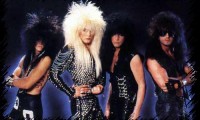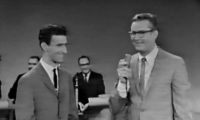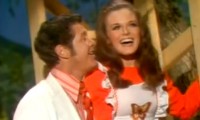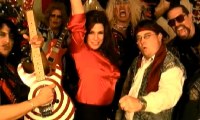“And there’s no bloody singer on it!”
— Iron Maiden’s Bruce Dickinson introducing ‘Losfer Words’ live
The Ventures, “Walk Don’t Run” (1960)
I come here today to praise the rock instrumental, not to bury it, even though it is, in my opinion, a dead art.
Not to say that there isn’t quality instrumental music out there these days but the time when a band like The Ventures could chart 38 albums and sell over 100 million records without a singer is long gone. In other words, the days when a teenager might flip on mainstream radio and hear instrumental music are over. Hell, it’s exceedingly rare for songs to even have long instrumental breaks à la “Freebird,” “Layla,” “Paradise City,” “One,” or “Halo of Flies” at this point.
The Golden Age of the mainstream instrumental spanned from the late 1950s to the late 1960s when The Ventures, The Shadows, Dick Dale, and Link Wray among others carved out careers of varying levels of success. Here’s The Ventures laying down a smoking version of The Surfaris’ “Wipe Out” with special guest drummer The E Street Band’s Max Weinberg alongside Mel Taylor.
The Ventures, “Wipe Out” (1989)
Obviously the original is better known at beach parties but I think The Ventures could eat The Surfaris for lunch and have room left over for dessert.
Of all the American instrumental bands, The Ventures were the best and most successful. They released a string of popular records but are still likely best remembered for the theme from the long-running TV series “Hawaii Five-O.”
Better then any other North American band of the time, they understood the essential key to the instrumental: the guitar does double duty. For the most part in a rock song, the rhythm section supplies the backbone, the beat, and the lead guitarist and singer are responsible for the melody. Remove the vocals and the guitar player must provide something for the listener to hum along to, effectively providing the vocal phrasing. As such, instrumental bands often had more than one lead guitarist, a circumstance we’ve already seen with The Ventures. Same goes for their English counterparts The Shadows, once the backup band for Cliff Richards.
The Shadows, “Apache” (1960)
The Shadows had a successful (and very long) career but were always more influential than popular. Black Sabbath’s Tony Iommi has cited their hand in some of his techniques, as has Queen’s Brian May. Deep Purple took their name from a Shadows tune.
By the early 1970s, the instrumental had largely become the province of newly emerged progressive rock bands, eager to show off their considerable musical talents at an extremely high technical level.
Emerson, Lake, & Palmer, “Barbarian” (1971)
Apparently this was written when Greg Lake heard Keith Emerson practicing a piano piece by the brilliant Hungarian composer Béla Bartók (1881-1945) and suggested that they work on it with some fuzz bass. The song was completed and released on their debut album in 1970.
Not long after they got a call at their offices (headquarters? I always imagined that ELP would have headquarters) from Bartók’s widow, who blithely informed them that their piece of music was written by her husband. It didn’t occur to them that a classical composition wouldn’t be in the public domain. I gather everything was settled quickly and amicably but the band felt like they’d been called out by Mrs. Mozart.
Focus, “Hocus Pocus” (1973)
This one by Dutch art-rock band Focus has it all: great riff, throbbing bass, fast drumming, flute, whistling, yodelling, what ?!?!? Released in 1971, it charted in the Top Ten in 1973. That bit of rondo-inspired weirdness was a hit single. Imagine that happening today. (Those of you familiar with the Steve Coogan BBC series “Saxondale” will recognize it as the music over the closing credits, by the way.)
And just for some CanCon, here’s Rush at their kimono-wearing best performing “La Villa Strangiato” from 1978’s “Hemispheres.”
Rush, “La Villa Strangiato” (1979)
Around this time, the first blow to the mainstream rock instrumental was delivered in the form of punk rock. The first wave of punk, with its three chord song structures, English class consciousness and spit-snarling attitude had little use for the art school graduates who created progressive rock.
For me the tipping point that ensured punk had to happen was when Yes’ Rick Wakeman committed the greatest of prog rock travesties: his recording of “The Six Wives of Henry VIII.” Showing off one’s musical prowess in the form of lengthy instrumentals was very much against punk rock aesthetic. Though I do recall (and someone can correct me if I have misremembered) that The Plasmatics once recorded one where each member of the band played for a few minutes on his own in the studio and they overlaid the tracks for a complete bit of utter cacophony.
With the general streamlining of pop/rock music in the 1980s, the instrumental became mostly the territory of guitar virtuosos and speed metal bands. After Eddie Van Halen recorded “Eruption” in 1978, it set the tone for hard rock guitar playing that would dominate much of the 1980s; a style divorced from the amplified blues of Jimmy Page and Joe Perry. Van Halen and Randy Rhoads played a faster, cleaner style born of classical training.
This gave rise to a caste of solo guitar players who would become the last artists to have moderate mainstream success performing instrumentals — people like Joe Satriani, Erik Johnson (along with a platoon of second-rate ‘shredders’) and Frank Zappa protégé Steve Vai.
Steve Vai, “The Audience is Listening” (2005)
I prefer this live recording to the studio version for two reasons: a) it is unencumbered by the chatter over the original, and b) around the 4:50 mark, it shows off the absurd level of coordination between Vai and his longtime bassist Billy Sheehan (their partnership dates back to 1986 when they were recruited for David Lee Roth’s first solo band).
Of this lot, I always thought Vai was the most talented in terms of musical breadth and imagination: He once recorded his wife’s labour pains and crafted a piece of music around them for God’s sake.
Around the same time speed metal bands were applying that level of proficiency to a type of music that was based on (initially anyway) sheer aggression. In the process they created some very impressive instrumentals like Anthrax’ “Intro to Reality,” MegaDeth’s “Into the Lungs of Hell” and the criminally underrated Wrathchild America’s “Prego” (so named because there’s a little of every musical style in there).
I will go to my grave maintaining that the best thing Metallica ever recorded was “The Call of Ktulu.” Though I know from old bootlegs that that the band used to perform it, I could not unearth any vintage video, which is a shame because it was such a showcase for the late Cliff Burton’s distinctive distorted bass style. Here though is another fine example from the title track of Death Angel’s 1987 debut album, “The Ultra Violence.”
Death Angel, “The Ultra Violence” (2007)
This is a shortened version (the original clocks in at over 10 minutes) and fairly recent footage but it sounds largely the same as it ever did. Bear in mind that when it was recorded no one in the band was over 19 and drummer Andy Galeon was a mere 14 years old.
In the intervening decades I’ve noticed that I go back to these pieces often, perhaps because heavy metal lyrics can be (at times) pretty hokey, so the pure music dates better. That said, I’ll listen to good music with bad lyrics over good lyrics with bad music any day of the week — the main reason I prefer Judas Priest to Bob Dylan.
Since the early 1990s, I’d argue that three changes in the music industry signalled the end of the mainstream instrumental. The first was grunge; the Seattle scene took aim not only at the showy and excessive façade of glam rock but also at heavy metal’s more baroque tendencies, particularly around guitar playing. Even the guitar solo, once a staple of any rock song, has mostly disappeared.
The second is the near wholesale takeover of mainstream music by rap and subsequently hip-hop, urban music rooted primarily in rhythm with less use for melody. As predominantly electronic music, what little instrumentation its proponents use is often borrowed/stolen/sampled from other artists, alongside a degree of visual posturing that would embarrass Poison.
The final (and certainly most odious) factor has been the rise of “American Idol” winner types. Because these ‘talent’ shows the world over are totally focused (as is hip-hop) on the cult of the vocalist, it’s rare for any of their songs to run eight bars without words. These are factories for solo singers in the Whitney Houston mode: They win their contests in front of anonymous TV network house bands, record with unknown session players, and tour with hired musicians that are barely seen by an audience that could hardly care if they were real or taped anyway.
Thank you very much, Simon Cowell.
– Christopher Doda






